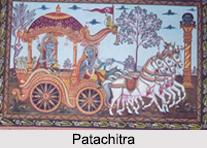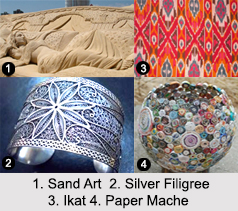 Arts of Odisha have undergone several modifications over the centuries and reflect the rich cultural heritage of this eastern Indian state. The regional artisans and sculptors of Odisha are well-known for their expertise in the spheres of various forms of art and crafts, paintings and sculptural marvels.
Arts of Odisha have undergone several modifications over the centuries and reflect the rich cultural heritage of this eastern Indian state. The regional artisans and sculptors of Odisha are well-known for their expertise in the spheres of various forms of art and crafts, paintings and sculptural marvels.
Art connoisseurs from all across the globe would readily agree to the fact that Odisha boasts of some of the most memorable specimens of local art, manifested through performing arts like folk dance and songs, filigree ornaments, `Patachitra` paintings, terracotta art, applique art, lacquer work and numerable others. The manifold forms of art existent in Odisha offered interesting commercial avenues with regions in different portions of India, as well as abroad.
History of Arts of Odisha
History of Odisha, which gained permanent recognition and magnificence under its past names, `Kalinga` and `Utkal`, dated back to very isolated remains. The history of art in Odisha dated back to early times with rock-cover paintings, some of them are dated to the early historic period (300BC-100AD). Despite the rock painting sites, a lot of the cave paintings are tribal and rock shelter painting has continued through the centuries as an Oriya tradition. Mural paintings in Odisha as elsewhere in India was an ancient tradition and support of mural colouring coverings have been found in the caves of Khandagiri and Udayagiri dating back to the reign of Emperor Kharavela who ruled in the 1st century B.C.
There is a mural belonging to later Gupta period and shows resemblance to those of the Ajanta style on the ceiling of Ravanachhaya in Keonjhar district. From the period of 1600 to present murals were painted in the frequent templates of Odisha depicting sacred figures such as the painting of Buddha Vijaya in the Jagamohana of Lakshmi Temple and within the Jagannath Temple at Puri, the Biranchinarayana Temple.
Types of Arts of Odisha
Odisha has an art and craft which are the products of a long historical development in which the religious, philosophical and the human aspects have joined to give in the best effects of a cultured and civilized life.
Paintings: Rock paintings, tribal paintings, Patachitra and palm leaf paintings are amongst the unique instances of Odisha art. Tribal paintings by `Sauras`, `Kondhs`, `Santhals`, etc are praiseworthy and are based on various themes and follow floral or geometrical patterns painted on Tussar Silk. Odisha possesses some famous rock paintings, particularly those at Ravana Chhata Rock al Sitabinjhee, Keonjhar which depicts the scene of a king riding an elephant followed by his soldiers. Other reputed rock paintings at Vikram Khol and Ulapgarh, Sambalpur, Ushakothi and Manikmada, Sundargarh and others deserves a mention.
Sand Art: An exclusive form of sand art is practised in Odisha, which is particularly done in Puri. Sand sculptors have been carving exquisite masterpieces of sand art as a part of their historical traditions. Presently, these art forms have become the avocation and vocation for innumerable people residing here. Classical art, folk art and tribal art are some of the most renowned art-forms which flourish in Odisha.
 Textile Art: Sarees of Odisha are in high demand amongst the ladies, especially `Sambalpuri Textiles` which includes the Sambalpuri Saree, available in a wide variety of designs and colours. Pasapalli, Bandha, Bomkai and Ikat are the various types of sarees indigenous to Odisha. A special tie-and-dye` process is used by the weavers of Odisha for creating patterns on such sarees impart a unique appeal to the sarees of Odisha.
Textile Art: Sarees of Odisha are in high demand amongst the ladies, especially `Sambalpuri Textiles` which includes the Sambalpuri Saree, available in a wide variety of designs and colours. Pasapalli, Bandha, Bomkai and Ikat are the various types of sarees indigenous to Odisha. A special tie-and-dye` process is used by the weavers of Odisha for creating patterns on such sarees impart a unique appeal to the sarees of Odisha.
Stone Carvings: The artisans of Odisha have still retained the glorious tradition of stone carving which has created a niche in the history of art in India. In sculpture and temple architecture, there exists a large variety of motifs and styles.
Silver Filigree: Silver filigree, the most unique & finest is locally called tarakasi. The craft is localized in the city of Cuttack and few of its villages. The process consists of drawing silver through a series of consecutively smaller holes to produce fine strands of wire.
Brass and Dhokra Works: Dhokra or bell metal craft is a tribal craft that combines skills with wax technique to create things of distinctive beauty, practiced for over 4,000 years.
Paper Mache: Paper Mache skill has been artistically practiced by crafts persons from all over Odisha since long. Masks, hand bags, toys are produced out of specifically made papers in Odisha which are not only stunning but strong and durable as well.
Horn Bone Craft: This art has been more than a century ago and its fame have only grown year after year.
Palm Leaf Etching: Messages and manuscripts were written on the palm leaf to be disseminated. It is mostly practiced by the artists primarily residing in Puri and Cuttack.
Terracotta Crafts: Terracotta crafts are made in every part of Odisha. The crafts are exquisite in design and bear the traits of the locality in which they are produced.
Coir Craft: Some of the popular animal figures include horses, crocodiles and dinosaurs. The lightweight, yellow coloured fibre is moulded into animal and bird designs as well as decorative items.
Ikat: Method of Ikat is subject to tying in sequences and dyeing the required areas in particular colours. Weaving in this technology started in Odisha.



















